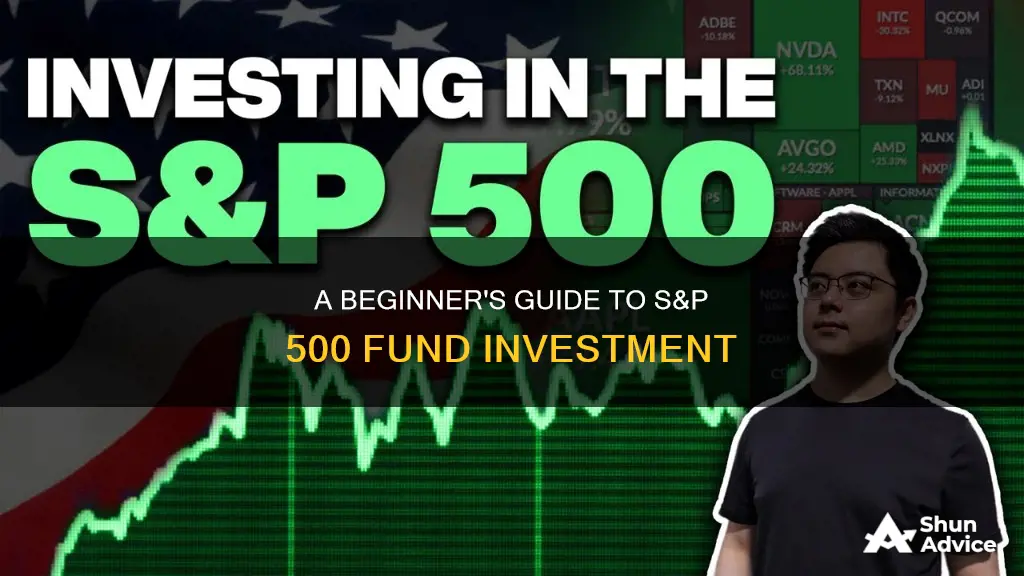
The S&P 500 is an index composed of 500 leading U.S. companies, and it powers some popular index funds. You can't invest directly in the S&P 500, but you can buy individual stocks of companies in the S&P 500, or buy an S&P 500 index fund or ETF. Index funds typically carry less risk than individual stocks.
The easiest way to invest in the S&P 500 is through an S&P 500 index fund or ETF. These funds aim to replicate the returns of the S&P 500 by tracking it, offering investors exposure to S&P 500 companies without the effort involved in purchasing the individual stock of each company.
You can purchase index funds and ETFs in a taxable brokerage account, or if you're investing for retirement, in a 401(k) or IRA, which come with added tax benefits.
| Characteristics | Values |
|---|---|
| What is the S&P 500? | The S&P 500 is an index made up of 500 of the largest companies in the U.S. |
| How to invest in the S&P 500 | You can buy individual stocks of companies in the S&P 500, or buy an S&P 500 index fund or ETF. |
| Advantages of investing in the S&P 500 | Exposure to the world's most dynamic companies, consistent long-term returns, intricate analysis not required, can serve as a core holding |
| Disadvantages of investing in the S&P 500 | The index is dominated by large-cap companies, the index has risks inherent in equity investing, only includes U.S. companies |
| Best S&P 500 index funds | Fidelity 500 Index (FXAIX), Fidelity Flex 500 Index (FDFIX), Schwab S&P 500 Index Fund (SWPPX), Vanguard 500 Index Admiral Fund (VFIAX), Invesco Equally-Weighted S&P 500 (VADAX) |
What You'll Learn

How to choose an S&P 500 index fund
When choosing an S&P 500 index fund, there are a few key criteria to keep in mind. Here are the steps you can follow:
- Expense Ratio: Expense ratios represent the fees charged by the fund manager for managing the fund, typically expressed as a percentage of your investment. Since S&P 500 index funds are passively managed, you should expect these fees to be relatively low. Compare the expense ratios of different funds and choose one with a low ratio, as this will maximize your returns over time.
- Sales Load: Sales load refers to the sales commission charged by the fund manager. This is an unnecessary expense, especially when it comes to index funds. Look for funds that do not charge a sales load, as this will reduce your overall costs.
- Minimum Investment: Different funds have different minimum investment requirements. Consider your budget and how much you can afford to invest initially. Some funds may also have minimum requirements for subsequent investments, so be sure to review the terms carefully.
- Dividend Yield: Dividends can boost your returns, even in down markets. Compare the dividend yields offered by different index funds and choose one that provides a higher dividend yield.
- Inception Date: If you prefer a fund with a proven track record, consider the inception date. Older funds will have a longer history, allowing you to evaluate their performance over time, including how they navigated bull and bear markets.
- No need to over-diversify: Remember, you only need one S&P 500 index fund in your portfolio. The returns of these funds tend to be very similar, so there is little benefit in splitting your assets between multiple funds.
Some popular S&P 500 index funds include:
- Fidelity 500 Index Fund (FXAI.X): This fund has one of the lowest expense ratios at 0.015% and has no minimum investment requirement, making it accessible to beginners.
- Schwab S&P 500 Index Fund (SWPP.X): Schwab's fund has a slightly higher expense ratio of 0.02% but also has no minimum investment.
- Vanguard 500 Index Fund Admiral Shares (VFIA.X): The Vanguard fund has a higher expense ratio of 0.04% and a minimum investment requirement of $3,000.
- Fidelity Flex 500 Index (FDFIX): This fund is completely free, but it is only available to active Fidelity Investments account holders.
Trust Fund Investment Strategies: Where to Begin?
You may want to see also

How to buy an S&P 500 index fund
The S&P 500 is a stock market index, which means it is a list of companies that are related in some way or otherwise grouped together. You can't directly invest in the S&P 500, but you can buy an S&P 500 index fund or exchange-traded fund (ETF) that tracks the index.
Here's how to buy an S&P 500 index fund:
- Find your S&P 500 index fund: Compare funds based on their expense ratio (the cost the fund manager will charge you over the year as a percentage of your investment) and sales load (a sales commission charged by the fund manager).
- Go to your investing account or open a new one: You can buy an S&P 500 index fund through a brokerage account, an individual retirement account (IRA), or a 401(k).
- Determine how much you can afford to invest: Figure out how much you're able to invest and how often you can add money to your account.
- Buy the index fund: Go to your broker's website and set up the trade, specifying the number of shares or the dollar amount you want to invest.
The S&P 500 is an index made up of 500 of the largest companies in the US. It is one of the stock market indexes often considered a proxy for the overall health of the US stock market. The S&P 500 weights the stocks by market capitalization, or total market value (the number of outstanding shares multiplied by the stock's current market price).
The S&P 500 has returned about 10% per year on average over long periods. It is a good option for investors who want to diversify their portfolios and buy shares of 500 of the largest US companies without having to purchase individual stocks.
If you are investing in an S&P 500 index fund, you will need to pay any expense ratio fees and meet any minimum investment requirements. If you are investing in an S&P 500 ETF, you will need to pay the share price (or a fractional amount, if your broker allows this) and any expense ratio fees. If you are investing in an individual stock within the S&P 500, you will need to pay the stock's share price.
Offshore Hedge Fund Investment: Strategies and Secrets Revealed
You may want to see also

The pros and cons of S&P 500 ETFs
S&P 500 ETFs are a good option for investors who want to diversify their stock portfolio and invest in 500 of the largest U.S. companies without having to buy individual stocks. They are also good for investors who want the flexibility to be able to buy or sell their fund at any point throughout the day. Beginners to the stock market may find this an easy way to invest in many companies at once.
Pros of S&P 500 ETFs
- Low cost compared to mutual funds
- Can help diversify a portfolio
- Commission-free trades through most brokerages
Cons of S&P 500 ETFs
- Lack of control over holdings as you can't sell in or out of particular companies
- Some expense ratios are higher than others
Additional Considerations
- S&P 500 ETFs are passively managed, meaning there isn't a Wall Street professional selecting which assets are added to and removed from the fund.
- S&P 500 ETFs are traded like stocks on exchanges, while mutual funds can only be traded at the end of each trading day. This makes ETFs more liquid and more accessible to ordinary investors.
Mutual Fund Investment Guide for Filipinos
You may want to see also

The pros and cons of S&P 500 index funds
The S&P 500 index fund is a popular investment choice, but like any investment, it has its pros and cons.
Pros
- Low fees and costs: Index funds are passively managed, meaning they have low fees and expense ratios compared to other funds. S&P 500 ETFs, in particular, tend to have low fees.
- Diversification: The S&P 500 index fund allows investors to hold a stake in hundreds of stocks, even with just one share of the fund. This broad collection of companies means investors can lower their risk through diversification.
- Easy to buy: It is simple to invest in index funds compared to buying individual stocks, as it requires little time and no investing expertise.
- Solid performance: The S&P 500 has historically returned an average of about 10% annually over time, offering consistent long-term returns.
- Exposure to large companies: The S&P 500 offers exposure to some of the world's most dynamic and largest companies, such as Apple, Amazon, Microsoft, and Johnson & Johnson.
- No intricate analysis required: Investors do not need to analyze or pick stocks with the S&P 500 index fund.
- Ideal as a core holding: S&P 500 index funds and ETFs are liquid and trade with tight bid-ask spreads, making them ideal as core holdings for most investment portfolios.
Cons
- Dominated by large-cap companies: The S&P 500 is dominated by large-cap companies, with its 10 biggest constituents accounting for almost one-third of the index. This means it has limited exposure to small-cap and mid-cap stocks, which may have higher growth potential.
- Risk: The S&P 500 has risks inherent in equity investing, such as volatility and downside risk, which may be difficult for newer investors to tolerate.
- US-centric: The S&P 500 only includes US companies, so it does not provide exposure to international markets.
- Lack of control: Investors cannot choose or sell particular companies within the index fund, so they have less control over their holdings.
- Some higher expense ratios: While S&P 500 index funds tend to have low fees, some expense ratios are higher than others.
- Not a complete portfolio: The S&P 500 should not make up an investor's entire portfolio. It is important to also include smaller and international companies to weather market volatility and for diversification purposes.
A Smart Guide to Investing in Dow Jones Index Funds
You may want to see also

How to monitor and rebalance your investments
Index rebalancing can cause significant shifts in trading volumes, affecting stock prices, sector trends, and broader market sentiment. Therefore, it is important to monitor and periodically rebalance your investments to ensure your portfolio remains aligned with your financial goals.
Monitor Your Investments
- Keep an eye on rebalancing events: The S&P 500 is rebalanced quarterly, usually on the third Friday of March, June, September, and December. However, changes can also occur outside of these dates due to company mergers, acquisitions, bankruptcies, or delistings.
- Understand the impact of rebalancing: Rebalancing can lead to portfolio adjustments, investment opportunities, and tax consequences. It can also affect sector weightings and the addition or deletion of individual securities.
- Stay informed: S&P Dow Jones publishes announcements related to rebalancing on their website.
Rebalance Your Investments
- Review your investment goals: Ensure your portfolio remains aligned with your financial objectives.
- Adjust your portfolio: If necessary, make changes to your asset allocation to match the new composition of the index.
- Consider tax implications: Rebalancing may result in capital gains or losses, which must be reported on tax returns.
- Collaborate with professionals: Consult with financial advisors or portfolio managers to navigate market changes and adapt your investment strategies effectively.
Vanguard Funds: Smart HSA Investment Strategies
You may want to see also
Frequently asked questions
The S&P 500 is an index composed of 500 leading U.S. companies. It is often considered a proxy for the overall health of the U.S. stock market.
You can't invest directly in the S&P 500. However, you can buy individual stocks of companies in the S&P 500, or buy an S&P 500 index fund or ETF.
Investing in an S&P 500 fund can instantly diversify your portfolio and is generally considered less risky than purchasing individual stocks directly.
The S&P 500 consists of only large-cap U.S. stocks. For true diversification, it's important to also buy mid- and small-cap companies, international companies, and other asset classes like bonds.







